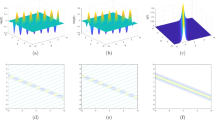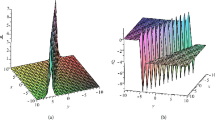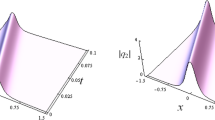Abstract
In this paper, we utilize the Riemann–Hilbert approach to discuss multi-soliton solutions of the N-component nonlinear Schrödinger equations. Firstly, by transformed Lax pair, we construct the matrix-valued functions \(P_{1,2}\) that satisfy the analyticity and normalization and the corresponding jump matrix can be determined. Then, in the reflectionless case, we get the multi-soliton solutions \(q_{l}\) \((l=1,\ldots ,N)\) of the N-component nonlinear Schrödinger equations, which are related to the spectral parameter \(\eta \). Particularly, the 2-soliton solutions \(q_{1}\), \(q_{2}\), and \(q_{3}\) of the three-component nonlinear Schrödinger equations are given and the corresponding 2-soliton diagrams are drawn.
Similar content being viewed by others
Explore related subjects
Discover the latest articles, news and stories from top researchers in related subjects.Avoid common mistakes on your manuscript.
1 Introduction
Riemann–Hilbert (RH) problem is the 21st question that Hilbert mentioned at the International Congress of Mathematicians in Paris [1]. It belongs to the scope of boundary value problem of matrix-valued functions on the complex plane. Usually, the RH problem is defined as follows [2]. Assume that \(\Sigma \) is a directed path on the complex plane \(\mathcal {C}\), \(\Sigma ^{0}\)=\(\Sigma \setminus \){self-intersection of \(\Sigma \)}. Suppose that there is a smooth map on \(\Sigma ^{0}\)
Then, \((\Sigma , G)\) determines a RH problem, i.e., looking for a \(n\times n\) matrix P(z), which satisfies
-
P(z) is analytical in \(\mathcal {C}\setminus \Sigma \);
-
P(z) satisfies the following jump condition
$$\begin{aligned} P_{+}(z)=P_{-}(z)G(z), z\in \Sigma ; \end{aligned}$$ -
\(P(z)\rightarrow I, z\rightarrow \infty \).
In fact, the RH problem is a boundary value problem of matrix value function on complex plane, and we can convert it into integral equations. Because RH problem is a problem on complex plane, the biggest advantage of RH approach is to transform the problem solvable on complex plane. For example, some definite integrals are difficult to integrate in the real domain, but can be solved when treated as complex integrals.
It is known that the methods by which the solutions of the integral equations can be obtained include inverse scattering transformation [3], Darboux transformation [4], symmetry reduction method [5], Hirota bilinear method [6], Lax pair nonlinear method [7], Wronskian technique [8], and so on. RH approach is a direct and simple method to solve the soliton equations. The problem can be solved by Lax pair of integrable systems and analysis of the spectral function. One can construct the RH problem similar to the above description, and then get the soliton solutions of the original equations.
Now RH approach has been developed into a powerful analytical tool to solve problems in a large class of pure and applied mathematics, which can be widely applied to initial boundary value problem [9,10,11,12,13,14,15,16], asymptotic of orthogonal polynomials [17], Bäcklund transformation [18, 19], and long-time asymptotics [20,21,22]. Afterward, It is found that the RH approach can be used to obtain the solutions of integral equations by inverse scattering theory [23,24,25,26,27,28,29,30]. In recent years, Wazwaz solved multiple soliton solutions of the equations [31,32,33,34]. Then, RH approach has been widely used to get multi-soliton solutions of multi-dimensional equations [35,36,37,38,39].
In this paper, we mainly discuss multi-soliton solutions of the N-component nonlinear Schrödinger (NLS) equations by RH approach. The N-component NLS equations [40] take the form
where \(q_{l}=q_{l}(t,x)\) \((l=1,\ldots ,N)\) are functions and the subscripts mean the partial derivatives.
The organization of this paper is given as follows. In Sect. 2, we transform Lax pair to construct the RH problem for the N-component NLS equations. In Sect. 3, the multi-soliton solutions for the N-component NLS equations are obtained, which are relevant to the spectral parameter. Then, the 2-soliton solutions of the three-component NLS equations are given and the corresponding 2-soliton graphs are drawn. In Sect. 4, we give the conclusion.
2 Riemann–Hilbert problem
Based on Eq. (1.1), we have the Lax pair
where
\(\eta \) is the spectral parameter. Then, we get the Jost solution of Lax pair (2.1) with asymptotic form by
In order to facilitate calculation, we define a matrix function \(\Psi =\Psi (x,t;\eta )\). Letting
then we have
The Lax pair (2.1) can be rewritten as
where \(U_{1}=iQ\) and \(U_{2}=i\eta Q+\frac{1}{2}(i\sigma Q^{2}-\sigma Q_{x})\). Then, the Volterra integral equations can be expressed as
By calculation, we can know
Let \(\Psi _{1}=([\Psi _{1}]_{1}, [\Psi _{1}]_{2},\ldots , [\Psi _{1}]_{N+1})\) and \(\Psi _{2}=([\Psi _{2}]_{1}, [\Psi _{2}]_{2},\ldots [\Psi _{2}]_{N+1}))\). Then, it can be obtained that \([\Psi _{1}]_{1}\) is analytic in \(\mathcal {C}^{-}\), \([\Psi _{1}]_{2},\ldots ,[\Psi _{1}]_{N+1}\) are analytic in \(\mathcal {C}^{+}\). \([\Psi _{2}]_{1}\) is analytic in \(\mathcal {C}^{+}\), \([\Psi _{2}]_{2},\ldots ,[\Psi _{2}]_{N+1}\) are analytic in \(\mathcal {C}^{-}\). We can rewrite \(\Psi _{1,2}\) as follows
Based on the properties of \(\Psi _{1,2}\) and tr Q=0, we can know that \(\det \Psi _{1,2}\) are independent for all x. By the asymptotic conditions \(\Psi _{1,2}\rightarrow I\) as \(|x|\rightarrow \infty \), we know that
Therefore, \(\Psi _{1,2}\) are linearly related by a spectral matrix \(S(\eta )=(s_{kj}(\eta ))_{(N+1)\times (N+1)}\), which can be expressed as
Then, we have
Taking the inverse of both sides of Eq. (2.12), we can obtain
Applying Eq. (2.14) and the analytic properties of column vectors of \(\Psi _{1,2}\), we can get the analytic properties of \(\Psi _{1,2}^{-1}\), that is
In order to construct a matrix RH problem, we need to determine two matrix functions
Let
Then, \(P_{1,2}\) can be rewritten as
where \(R(\eta )=S^{-1}(\eta )=(r_{kj}(\eta ))_{(N+1)\times (N+1)}\). We can study the asymptotic expansion of \(P_{1}\)
Submitting (2.20) into the first equation of (2.6) and comparing the corresponding coefficients of \(\eta \), we obtain
We can get
Similarly,
By the above calculation, we propose the RH problem of the N-component NLS equations
-
\(P_{1}(t,x;\eta )\) is analytic in \(\mathcal {C}^{+}\), \(P_{2}(t,x;\eta )\) is analytic in \(\mathcal {C}^{-}.\)
-
\(P_{2}(t,x;\eta )P_{1}(t,x;\eta )=G(t,x;\eta ), ~~\eta \in \mathcal {R}\),
-
\(P_{1,2}(t,x;\eta )\rightarrow I, ~~~as ~\eta \rightarrow \infty ,\)
where the jump matrix takes the form
3 Multi-soliton solutions of the N-component NLS equations
3.1 Multi-soliton solutions
In this section, we can get the multi-soliton solutions of Eq. (1.1). Firstly, we should derive the properties of the zeros of \(\det P_{1,2}(\eta )\). On the basis of Eqs. (2.18) and (2.19), we can get
In other words, zeros of \(\det P_{1}(\eta )\) are zeros of \(r_{11}(\eta )\) and zeros of \(\det P_{2}(\eta )\) are zeros of \(s_{11}(\eta )\). Obviously, Q defined by (2.2) is a Hermite matrix, that is
where \(\dag \) means conjugate transpose. Using Eqs. (2.18)-(2.19) and \(\Psi _{1,2}^{\dag }(\eta ^{*})=\Psi _{1,2}^{-1}(\eta )\), we can get the following relationship
Then, it follows from the scattering relation (2.12) that
The points \(\eta _{j}\) \((j=1,2,\ldots ,N)\) are zeros of \(\det P_{1}(\eta )\) in \(\mathcal {C}^{+}\), and \(\eta _{j}^{*}(j=1,2,\ldots ,N)\) are zeros of \(\det P_{2}(\eta )\) in \(\mathcal {C}^{-}.\) According to \(\det P_{1}(\eta _{j})=\det P_{2}^{*}(\eta ^{*}_{j})\), we suppose that nonzero column vectors \(\nu _{j}\) and nonzero row vectors \(\nu _{j}^{*}\) are the solutions of the following linear equations, respectively,
In fact, the scattering data for solving the RH problem (2.24) is composed of the discrete scattering data \(\{\eta _{j},\eta _{j}^{*},\nu _{j},\nu _{j}^{*}\}\) and the continuous scattering data \(\{s_{21}, s_{31},\ldots ,s_{N+1,1}\}\). From Eqs. (3.3) to (3.5), we get
Differentiating Eq. (3.5) with respect to x and considering Lax pair (2.6) and Eq. (3.6), we obtain
where \(\nu _{j0}\) are the \((N+1)\)-dimensional constant column vectors. Then, we can get multi-soliton solutions for Eq. (1.1) in the reflectionless case. Define the matrix \(M=(M_{kj})_{(N+1)\times (N+1)}\)
Based on the canonical normalization condition (2.16), the RH problem has the unique solution
Then, we can expand \(P_{1}\) as follows
Putting the asymptotic expansion (3.10) into Eq. (2.6), we have
Hence, the potential functions \(q_{l}\) \((l=1,2,\ldots ,N)\) can be expressed as
where \(({P_{1}^{(1)}})_{l+1,1}\) \((l=1,2,\ldots ,N\)) are the (\(l+1\),1) entry of matrix \(P_{1}^{(1)}\), which can be obtained from Eq. (3.9), that is
Substituting Eq. (3.7) into Eq. (3.13), a general multi-soliton solutions for the N-component NLS equations can be shown as
where \(\nu _{k}=(\nu _{k1}, \nu _{k2},\ldots ,\nu _{k,N+1})^{T}\) and \(\nu _{j}^{*}=(\nu _{j1}^{*}, \nu _{j2}^{*},\ldots ,\nu _{j,N+1}^{*})\) \((k,j=1,2,\ldots ,N)\) are defined by Eq. (3.7).
3.2 2-soliton solutions
Particularly, we can study the case of \(N=3\). The three-component NLS equations can be written as
We can obtain the soliton solutions for this particular case. Assuming \(\nu _{1,0}=(\alpha _{1},\beta _{1},\gamma _{1},\epsilon _{1})^{T}\), \(\nu _{2,0}=(\alpha _{2},\beta _{2},\gamma _{2},\epsilon _{2})^{T}\), and letting \(\xi _{1}=-i\eta _{1}x-i\eta _{1}^{2}t\), \(\xi _{2}=-i\eta _{2}x-i\eta _{2}^{2}t\), \(\eta _{1}=a_{1}+ib_{1}\), \(\eta _{2}=a_{2}+ib_{2}\). We can get 2-soliton solutions as follows
where
By selecting appropriate parameter values \(\alpha _{1}=\alpha _{2}=1\), \(\beta _{1}=\beta _{2}=\frac{1}{4}\), \(\gamma _{1}=\gamma _{2}=\frac{\sqrt{59}}{8}\), \(\epsilon _{1}=\epsilon _{2}=\frac{1}{8}\), \(a_{1}=-0.1\), \(b_{1}=0.2\), \(a_{2}=0.2\), and \(b_{2}=0.3\), three-dimensional plots and x-curves of solutions are shown in Figs. 1, 2, 3, 4, 5, and 6.
4 Conclusion
In general, we investigate the multi-soliton solutions of the N-component NLS equations via RH approach.
By the Volterra equations, the corresponding analytical properties can be obtained. Then, we define \(P_{1}\) and \(P_{2}\) to construct the RH problem. In reflectionless case, making full use of the symmetric relation of the potential matrix and giving the zero point relation of the determinant of two analytic matrix functions in the problem, one can construct the multi-soliton solutions. For the multi-component NLS equations, it is more complicated than standard NLS equations. The multi-soliton solutions of N-dimensional NLS equations via the RH approach have not been well studied before, and therefore we take the factor of multi-component into consideration.
RH approach can be used not only to solve the initial boundary value problem of integrable systems, but also to analyze the solution of long-time behavior, quantum field theory and statistical model, orthogonal polynomial theory, and random matrix theory. In addition, it can be used in plasma physics, ocean engineering, atmospheric sciences, Bose–Einstein condensate, nonlinear optics and so on. The Riemann–Hilbert approach can be applied to many equations of similar types. In future, we can innovate and improve the method and apply it to many more complex equations.
References
Hilbert, D.: Mathematics problem. Gott. Nachr. 3, 253–297 (1990)
Faddeev, L.D., Takhtajan, L.A.: Hamiltonian Methods in the Theory of Solitons. Springer-Verlag, Berlin (1987)
Zhou, G.Q., Huang, N.N.: An N-soliton solution to the DNLS equation based on revised inverse scattering transform. J. Phys. A-Math. Theor. 40(45), 13607 (2007)
Zhaqilao, Z., Yong, C., Li, Z.B.: Darboux transformation and multi-soliton solutions for some soliton equations. Chaos Soliton Fractal 41(2), 661–670 (2009)
Mei, J.Q., Zhang, H.Q.: Symmetry reductions and explicit solutions of a (3+1)-dimensional PDE. Appl. Math. Comput. 211(2), 347–353 (2009)
Wazwaz, A.M.: The Hirota’s bilinear method and the tanh–coth method for multiple-soliton solutions of the Sawada–Kotera–Kadomtsev–Petviashvili equation. Appl. Math. Comput. 200(1), 160–166 (2008)
Zen, F.P., Elim, H.I.: Lax pair formulation and multi-soliton solution of the integrable vector nonlinear Schrödinger equation. Physics (1999)
Nimmo, J.J.C., Freeman, N.C.: A method of obtaining the N-soliton solution of the Boussinesq equation in terms of a Wronskian. Phys. Lett. A 95(1), 4–6 (1983)
Bikbaev, R.F.: Soliton generation for initial-boundary-value problems. Phys. Rev. Lett. 68, 3117–3120 (1992)
Jenkins, R., Liu, J., Perry, P., Sulem, C.: Soliton resolution for the derivative nonlinear Schrödinger equation. Commun. Math. Phys. 363, 1003–1049 (2018)
Xu, J., Fan, E.G.: The three-wave equation on the half-line. Phys. Lett. A 378, 26–33 (2014)
Hu, B.B., Zhang, L., Zhang, N.: On the Riemann–Hilbert problem for the mixed Chen–Lee–Liu derivative nonlinear Schrödinger equation. J. Comput. Appl. Math. 390, 113393 (2021)
Hu, B.B., Zhang, L., Xia, T.C.: On the Riemann–Hilbert problem of a generalized derivative nonlinear Schrödinger equation. Commun. Theor. Phys. 73, 015002 (2021)
Monvel, A., Shepelsky, B.D.C.: Riemann–Hilbert approach for the Camassa–Holm equation on the line. Comptes Rendus Mathematique 343, 627–632 (2006)
Wei, H.Y., Xia, T.C.: Constructing variable coefficient nonlinear integrable coupling super AKNS hierarchy and its self-consistent sources. Math. Method. Appl. Sci. 41, 6883–6894 (2018)
Hu, B.B., Zhang, L., Xia, T.C., Zhang, N.: On the Riemann–Hilbert problem of the Kundu equation. Appl. Math. Comput. 381, 125262 (2020)
Wong, R.: Asymptotics of orthogonal polynomials via the Riemann–Hilbert approach. Acta Math. Sci. 29, 1005–1034 (2009)
Liu, L.C., Tian, B., Qin, B.: Bäcklund transformation, superposition formulae and N-soliton solutions for the perturbed Korteweg–de Vries equation. Commun. Nonlinear Sci. 17, 2394–2402 (2012)
Zhang, Y., Chen, D.Y.: Bäcklund transformation and soliton solutions for the shallow water waves equation. Chaos Soliton Fractal 20, 343–351 (2004)
Wang, D.S., Wang, X.L.: Long-time asymptotics and the bright N-soliton solutions of the Kundu–Eckhaus equation via the Riemann–Hilbert approach. Nonlinear Anal.-Real. 41, 334–361 (2018)
Geng, X.G., Wang, K.D., Chen, M.M.: Long-time asymptotics for the spin-1 Gross–Pitaevskii equation. Commun. Math. Phys. 382, 1–27 (2021)
Cheng, Q.Y., Fan, E.G.: Long-time asymptotics for a mixed nonlinear Schrödinger equation with the Schwartz initial data. J. Math. Anal. Appl. 489, 124188 (2020)
Geng, X.G., Wu, J.P.: Riemann–Hilbert approach and N-soliton solutions for a generalized Sasa–Satsuma equation. Wave Motion 60, 62–72 (2016)
Ma, W.X.: The inverse scattering transform and soliton solutions of a combined modified Korteweg–de Vries equation. J. Math. Anal. Appl. 471, 796–811 (2019)
Chen, X.T., Zhang, Y., Liang, J.L., Wang, R.: The N-soliton solutions for the matrix modified Korteweg–de Vries equation via the Riemann–Hilbert approach. Eur. Phys. J. Plus 135, 574 (2020)
Wu, J.P.: Integrability aspects and multi-soliton solutions of a new coupled Gerdjikov–Ivanov derivative nonlinear Schrödinger equation. Nonlinear Dyn. 96, 789–800 (2019)
Xu, T., Chen, Y.: Riemann–Hilbert approach of the coupled nonisospectral Gross–Pitaevskii system and its multi-component generalization. Commun. Nonlinear Sci. 57, 276–289 (2017)
Li, J., Xia, T.C.: N-soliton solutions for the nonlocal Fokas–Lenells equation via RHP. Appl. Math. Lett. 98, 113 (2020)
Ma, W.X.: Riemann–Hilbert problems and N N mathContainer loading Mathjax-soliton solutions for a coupled mKdV system. J. Geom. Phys. 132, 45–54 (2018)
Wen, L., Zhang, N., Fan, E.G.: N-soliton solution of the Kundu-type equation via Riemann–Hilbert approach. Acta Math. Sci. 40, 113–126 (2020)
Wazwaz, A.M.: The extended tanh method for new solitons solutions for many forms of the fifth-order KdV equations. Appl. Math. Comput. 184, 1002–1014 (2007)
Wazwaz, A.M.: Multiple soliton solutions and multiple singular soliton solutions of the modified KdV equation with first-order correction. Phys. Scr. 82, 055006 (2010)
Wazwaz, A.M.: Multiple soliton solutions and multiple complex soliton solutions for two distinct Boussinesq equations. Nonlinear Dyn. 85, 731–737 (2016)
Wazwaz, A.M.: Two-mode fifth-order KdV equations: necessary conditions for multiple-soliton solutions to exist. Nonlinear Dyn. 87, 1685–1691 (2017)
Kang, Z.Z., Xia, T.C., Ma, W.X.: Riemann–Hilbert approach and N-soliton solution for an eighth-order nonlinear Schrödinger equation in an optical fiber. Adv. Differ. Equ. 188, 1–14 (2019)
Yang, J.J., Tian, S.F., Peng, W.Q., Zhang, T.T.: The N-coupled higher-order nonlinear Schrödinger equation: Riemann–Hilbert problem and multi-soliton solutions. Math. Methods Appl. Sci. 43, 1–15 (2019)
Li, P.R.: The solvability and explicit solutions of singular integral-differential equations of non-normal type via Riemann–Hilbert problem. J. Comput. Appl. Math. 374, 112759 (2020)
Li, J., Xia, T.C.: A Riemann–Hilbert approach to the Kundu-nonlinear Schrödinger equation and its multi-component generalization. J. Math. Anal. Appl. 500, 125109 (2021)
Wei, H.Y., Fan, E.G., Guo, H.D.: Riemann–Hilbert approach and nonlinear dynamics of the coupled higher-order nonlinear Schrödinger equation in the birefringent or two-mode fiber. Nonlinear Dyn. 43, 1–12 (2021)
Ling, L.M., Zhao, L.C., Guo, B.L.: Darboux transformation and multi-dark soliton for N-component nonlinear Schrödinger equations. Nonlinearity 28, 3243–3261 (2015)
Author information
Authors and Affiliations
Corresponding authors
Additional information
Publisher's Note
Springer Nature remains neutral with regard to jurisdictional claims in published maps and institutional affiliations.
The work is supported by the National Natural Science Foundation of China (Grant No. 11971297)
Rights and permissions
About this article
Cite this article
Li, Y., Li, J. & Wang, R. Multi-soliton solutions of the N-component nonlinear Schrödinger equations via Riemann–Hilbert approach. Nonlinear Dyn 105, 1765–1772 (2021). https://doi.org/10.1007/s11071-021-06706-7
Received:
Accepted:
Published:
Issue Date:
DOI: https://doi.org/10.1007/s11071-021-06706-7










